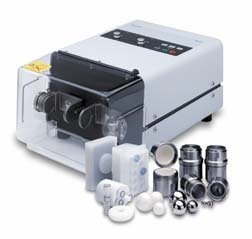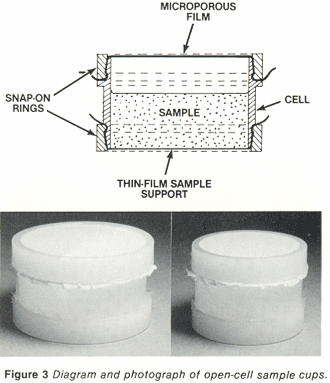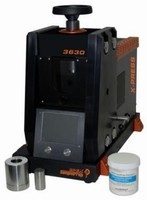XRF


 plastics,
metals, woods, and textiles. These material categories are then
further sorted into color groupings; this is necessary since even if
the same plastic was used throughout the toy product, the dye or paint
could hold the specific contaminants we are looking for. These
pieces are then ground using a Mixing Mill pictured at upper
right. The mixing mill has different griding tools for different
mediums, texture or grain size. When we used the term uniform to
describe the sample we are talking about the
plastics,
metals, woods, and textiles. These material categories are then
further sorted into color groupings; this is necessary since even if
the same plastic was used throughout the toy product, the dye or paint
could hold the specific contaminants we are looking for. These
pieces are then ground using a Mixing Mill pictured at upper
right. The mixing mill has different griding tools for different
mediums, texture or grain size. When we used the term uniform to
describe the sample we are talking about the grain size of the ground material. If the grain size is large
their will be open air space in the
sample which can affect the readings. Also if the grain size
varies the sample could settle unevenly and also
affect the readings. Grain size is mostly a variable
when the sample is manually tamped, when the container is tapped
to force the powder to settle the finer grains will sometimes settle on
the top. If the sample is prepared and then manually compressed
this becomes less of an issue since the particles are not given a
chance to moved or settle, they are compressed exactly as they fell
into the container and the sample remains more uniform even though it
may be made of different substances (http://www.jensentechnologiesllc.com/XRF2.html).
Automated presses like the one pictured to the lower right are also
available, their advantage is that they a programmable and can produce
consistent samples which lead to consistent results. Another
option are the toy parts have been ground into a fine powder is to fuse
them into uniform size beads. The powdered sample is mixed with
flux and heated to form uniform glass like beads.
grain size of the ground material. If the grain size is large
their will be open air space in the
sample which can affect the readings. Also if the grain size
varies the sample could settle unevenly and also
affect the readings. Grain size is mostly a variable
when the sample is manually tamped, when the container is tapped
to force the powder to settle the finer grains will sometimes settle on
the top. If the sample is prepared and then manually compressed
this becomes less of an issue since the particles are not given a
chance to moved or settle, they are compressed exactly as they fell
into the container and the sample remains more uniform even though it
may be made of different substances (http://www.jensentechnologiesllc.com/XRF2.html).
Automated presses like the one pictured to the lower right are also
available, their advantage is that they a programmable and can produce
consistent samples which lead to consistent results. Another
option are the toy parts have been ground into a fine powder is to fuse
them into uniform size beads. The powdered sample is mixed with
flux and heated to form uniform glass like beads.| Spectroscopy Home |
Toy Safety Standards |
Sample Preparation |
| XRF |
AAS |
Lesson Plan |